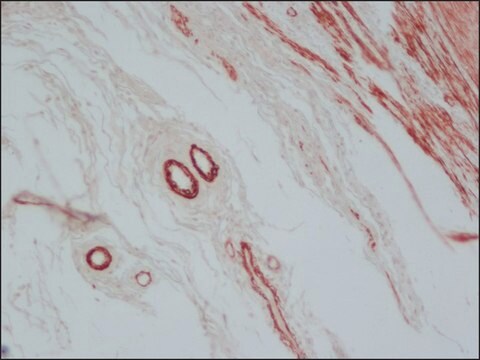B0684
Anti-Bad antibody produced in rabbit
affinity isolated antibody, lyophilized powder
Synonym(s):
Anti-BBC2, Anti-BCL2L8
Sign Into View Organizational & Contract Pricing
All Photos(1)
About This Item
Recommended Products
biological source
rabbit
Quality Level
conjugate
unconjugated
antibody form
affinity isolated antibody
antibody product type
primary antibodies
clone
polyclonal
form
lyophilized powder
species reactivity
mouse, human
technique(s)
western blot: 1 μg/mL
UniProt accession no.
storage temp.
−20°C
target post-translational modification
unmodified
Gene Information
human ... BAD(572)
mouse ... Bad(12015)
Related Categories
General description
Bad (Bcl-2-antagonist of cell death), initially identified by its interaction with Bcl-2 and Bcl-XL, is a distant Bcl-2 family member. Bad bears only the most universally conserved amino acids within BH1 and BH2 domains, and lacks the typical hydrophobic C-terminal signal anchor.
Immunogen
synthetic peptide corresponding to amino acids 1-21 of human Bad conjugated to KLH.
Application
Anti-Bad antibody produced in rabbit is suitable for western blotting at a concentration of 1μg/mL
Biochem/physiol Actions
The protein encoded by this gene forms heterodimers with BCL-xL and BCL-2 and replaces Bax, which in turn inverts the death repressor activity of Bcl-xL and positively regulates cell apoptosis.Bad is phosphorylated on two serine residues embedded in canonical 14-3-3 binding sites in response to IL-3, a survival factor. Phosphorylated Bad does not bind Bcl-XL and is sequestered in the cytosol bound to 14-3-3, a specific phosphoserine-binding protein. The growth factors that promote cell survival activate the threonine kinase Akt, which phosphorylates Bad causing suppression of apoptosis.
Physical form
lyophilized from a 0.2 μm filtered solution of phosphate buffered saline (PBS) and 5% trehalose
Disclaimer
Unless otherwise stated in our catalog or other company documentation accompanying the product(s), our products are intended for research use only and are not to be used for any other purpose, which includes but is not limited to, unauthorized commercial uses, in vitro diagnostic uses, ex vivo or in vivo therapeutic uses or any type of consumption or application to humans or animals.
Not finding the right product?
Try our Product Selector Tool.
recommended
Product No.
Description
Pricing
Storage Class
11 - Combustible Solids
wgk_germany
WGK 3
flash_point_f
Not applicable
flash_point_c
Not applicable
ppe
Eyeshields, Gloves, type N95 (US)
Choose from one of the most recent versions:
Already Own This Product?
Find documentation for the products that you have recently purchased in the Document Library.
K Wang et al.
Molecular and cellular biology, 18(10), 6083-6089 (1998-09-19)
The BCL-2 family of proteins is comprised of proapoptotic as well as antiapoptotic members (S. N. Farrow and R. Brown, Curr. Opin. Genet. Dev. 6:45-49, 1996). A prominent death agonist, BAX, forms homodimers and heterodimerizes with multiple antiapoptotic members. Death
Lishuai Feng et al.
International journal of molecular medicine, 42(2), 1074-1085 (2018-05-12)
Mono‑unsaturated free fatty acids (FFAs) can serve as a predictive indicator of vascular restenosis following interventional therapy, particularly in individuals with high‑fat diet‑induced type 2 diabetes. However, the pathogenic mechanism remains to be fully elucidated. In the present study, the
E Yang et al.
Cell, 80(2), 285-291 (1995-01-27)
To extend the mammalian cell death pathway, we screened for further Bcl-2 interacting proteins. Both yeast two-hybrid screening and lambda expression cloning identified a novel interacting protein, Bad, whose homology to Bcl-2 is limited to the BH1 and BH2 domains.
Bcl-2 heterodimerizes in vivo with a conserved homolog, Bax, that accelerates programmed cell death.
Z N Oltvai et al.
Cell, 74(4), 609-619 (1993-08-27)
Bcl-2 protein is able to repress a number of apoptotic death programs. To investigate the mechanism of Bcl-2's effect, we examined whether Bcl-2 interacted with other proteins. We identified an associated 21 kd protein partner, Bax, that has extensive amino
Our team of scientists has experience in all areas of research including Life Science, Material Science, Chemical Synthesis, Chromatography, Analytical and many others.
Contact Technical Service







